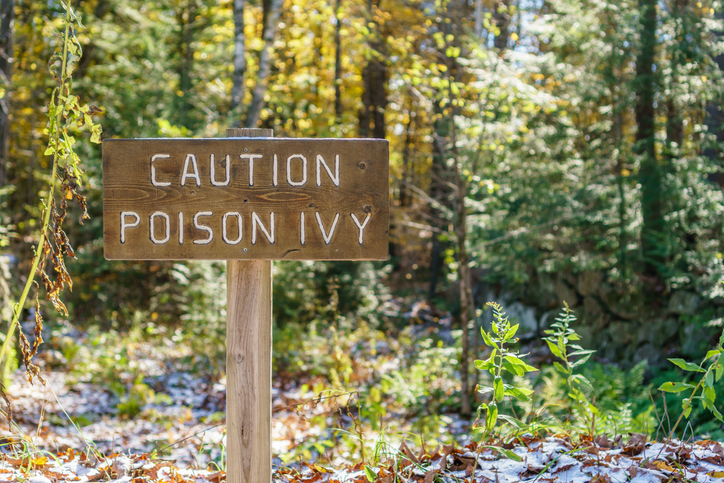
iStock
By Mary Carpenter
In this entry to MyLittleBird’s 2022 Summer Update series, Mary discusses Skin Scourges of Summer, adding recent data about effects of climate change on the toxicodendrons—poison ivy, oak and sumac; along with better advice about how to respond in case of accidental contact.
FOR THE poison ivy plant in particular, higher levels of carbon dioxide in the air have spurred explosive growth, creating leaves so large the plant is barely recognizable—and leading to higher levels and greater potency of the urushiol oil that causes the allergic dermatitis rash.
Updated poison ivy warnings emphasize the tenacious endurance of urushiol oil on garden tools and everything else that comes into contact with the plant. Merely by cutting or pulling out the vine, urushiol can spread through the air onto the most carefully covered weeder. The best recourse after gardening is an immediate and thorough washing— not just everywhere on the body, but also the clippers, gloves, clothes and shoes.
Afflicted sufferers can find the rash unbearable— impeding daily activities and preventing sleep. A towel or other soft cloth soaked in cool or lukewarm, salty water can offer the quickest relief. But medicine-cabinet staples, including antihistamines like Benadryl, “do not help to relieve itching caused by poison ivy dermatitis,” according to Up to Date. Low-potency OTC steroid creams are also unhelpful, while antihistamine creams or lotions can make the rash worse.
Prescription-strength steroid creams can work better than OTC products for itching and redness, according to Drugs.com. But if the rash affects the face, hands or genitals, or covers more than 10% of the skin, most doctors prescribe corticosteroid pills that can “dramatically reduce symptoms.” Stopping any prescription steroid before the specified period can cause the rash to reappear.
More from Mary’s earlier post on Summer Skin Scourges:
Pool chlorine dries the skin but swimming anywhere else has risks. Swimmer’s itch —also called clam digger’s itch—comes from lakes, ponds and oceans where water parasites, often from bird droppings, can burrow into the skin to cause welts or blisters on areas that bathing suits don’t cover. A brisk towel rubdown can help remove critters when washing is unavailable.
Conversely, seabather’s eruption—or pica-pica—appears on areas of the body covered by bathing attire, including flippers and masks, when newly hatched jellyfish or sea anemones get trapped inside, most commonly in the waters off Florida and Long Island, NY.
Summer warmth can provoke prickly heat— miliaria or heat rash— when blocked sweat glands cause sweat to build up under the skin, producing itchy bumps. While sunburn appears uniformly red and only on exposed skin, heat rash occurs anywhere moisture can get trapped, particularly under the arms. Bursting bumps release sweat to create a prickly sensation. Common-sense advice suggests trying to avoid profuse sweating—for example, by reducing exertions during the hottest or most humid periods of the day.
Melasma, which looks more like sunburn, is a disorder that produces gradual pigmentation of the skin. Sunlight can provoke flares in summertime, while the condition can improve in the winter. Another ongoing skin condition that becomes worse in summertime is folliculitis—also known as “hot tub folliculitis” — that occurs when hair follicles become infected and often resembles pimples. The best recourse when possible is changing out of tight workout clothes or wearing looser-fitting options—and stay away from hot tubs, which can have irritating high chlorine and acid levels.
Small, scaly skin patches are most often actinic keratosis—also called solar keratosis— the most common early-warning sign of skin cancer. (Actinic refers to chemical changes produced by radiant energy—described as photochemical reactions, as in photography.) The two main non-melanoma or keratinocyte carcinomas are basal cell, occurring mostly on the face and neck, from which 80% of skin cancers develop; and squamous cell, found all over the body and accounting for 20% of skin cancers. The most dangerous skin cancer is melanoma, which can spread throughout the body.
Beachgoers incur additional risks in summertime. Pathogens that lurk in the sand include dermatophytes that can cause ringworm and athlete’s foot. In addition, hookworms and roundworms can enter the body through bare feet, or bare skin, but usually die after about six weeks.
The most familiar sand-borne bug, Staphylococcus aureus, or S. aureus, usually lives benignly on the skin but can penetrate through a cut or lesion. The most worrisome, antibiotic-resistant MRSA (multi-resistant staph aureus) has appeared in samples of sand and seawater from southern California beaches, although it’s unclear whether that bacteria has led to infections.
Milder staph infections can cause the skin sores of impetigo, which commonly afflict children and can run rampant on local beaches. For me, even after severe bouts of poison ivy, ringworm and dry skin, the worst summer skin experience involved being asked by a lifeguard to leave a private beach after someone reported seeing my bared waist covered with weeping impetiginous sores.
—Mary Carpenter regularly reports on need-to-know topics in health and medicine

Great post!